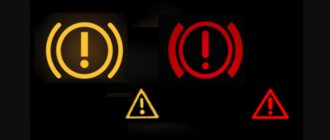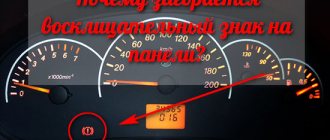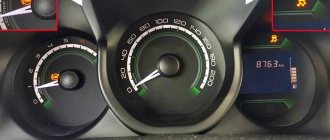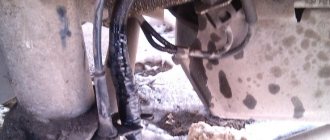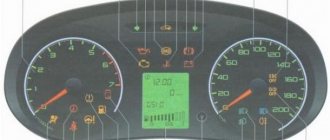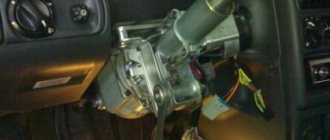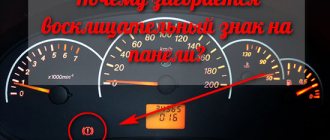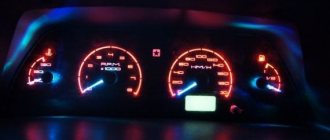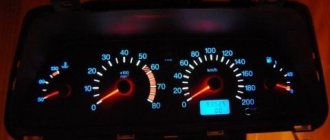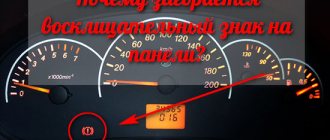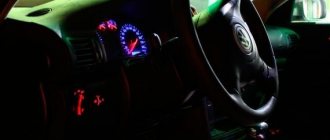A red exclamation mark that lights up in the lower instrument panel indicates a problem with the brake system. To be more precise, about the low level of brake fluid in the system. And this is understandable. Driving with faulty brakes is extremely dangerous. Not every driver, especially a beginner, knows how to brake with the clutch pedal. And this method of braking is not desirable, since it literally burns the disks of this unit. The brakes should be constantly monitored. A self-respecting driver will never start the engine without making sure the brakes are working properly. If an exclamation mark is lit on the instrument panel of a VAZ 2114, this is a serious warning - it is unsafe to drive this car. Below you will find out what the exclamation mark on the VAZ 2114 means and what problems this icon on the dashboard warns about.
How to remove the tidy
To dismantle the panel you will need to perform a sequence of actions.
- Disconnect the machine and place it in a stable position.
- Lower the steering wheel completely to the lowest position.
- Remove the plastic column casing by unscrewing the fastening screws.
- Next, you need to use special spatulas or a flat-head screwdriver. You will need to snap out the plastic clips securing the instrument panel trim.
- After removing all the facings, you should unscrew the 4 screws that secure the shield itself.
- After this, you will need to lift the board and turn off the contact groups of the devices.
- Now you can completely remove the shield from the car.
Error codes VAZ 2115
The VAZ company develops on-board computers so that fault codes for Lada 2115 and other models can be read in two ways at once.
The self-diagnosis procedure involves collecting and decoding errors through the on-board display. This method is suitable for quick repairs and troubleshooting.
From 2005 to 2022, more accurate diagnostics became possible. A specially designed OBD2 port allows you to connect equipment to the car. An external computer shows problems down to every detail.
BMW
Exclamation mark on the instrument panel: what does it mean
BMW cars are prone to problems with various indicators on the dashboard. In versions E60, E90 and X1, a flashing exclamation mark, depending on the type of additional lamps, may indicate a malfunction of the following systems:
- tire puncture;
- failure of the ABS or directional stability system;
- critical battery discharge;
- on automatic machines it may indicate overheating of the lubricant in the crankcase of the mechanism;
- when the “check engine” light comes on at the same time, it indicates a drop in the oil level;
- a breakdown in the brake line or the electrical part of the handbrake.
Some vehicle modifications may have different meanings. Accurate decoding of the indicators is carried out by connecting a diagnostic computer.
Identification of buttons
It is also important to know the designation of the buttons on the VAZ 2114 panel. On the instrument cluster on the right side there is a button (11), with which the time and temperature on the digital indicator are switched, and when pressed for 5 seconds or more, the current mileage is reset, if pressed this button on a stationary car.
In the central part of the dashboard are located in a row:
Buttons VAZ 2114
Double headlight switch. Button 1 turns on the dimensions, button 2 turns on the low beam;
Buttons on VAZ 2114
Key switch block. The first 1 turns on the front fog lights, the second 2 turns on the rear fog lights and the third 3 turns on the heated rear window.
Car : VAZ-2112. Asks : Sergey Smirnov. The essence of the question : An exclamation mark lit up on the instrument panel of the VAZ-2112, I don’t understand why?
Good afternoon I sometimes get an exclamation mark in a circle on my dashboard, most often this happens when braking! Please tell me what could be the reason and how to solve it?
Where does a brake fluid leak occur?
Exclamation mark on the instrument panel
A fuel fluid leak can lead to vehicle failure. When an exclamation mark on the instrument panel in a car indicates the occurrence of such a problem, you will have to check the system carefully.
Brake cylinder
A low level of brake fluid and signs of leakage indicate problems with the brake cylinder, which means it is damaged or needs a thorough inspection. While driving, the driver is able to feel uneven fluid pressure - in this case, the car will pull in one direction.
Leaks are often caused by rubber gaskets that cannot withstand freezing temperatures. If they become insufficiently elastic, it is time to install new ones.
Brake hoses
Damage to hoses—the main brake lines—is inexpensive to repair, but is a serious problem. Such a breakdown must be repaired as soon as it is discovered. Unnatural pressing of the brake pedal may indicate the presence of such damage - the car owner will find that the resistance has disappeared.
The problem can be found by visual inspection or palpation. If rubber components have lost their flexibility and crack when pressed, they need to be replaced. Sometimes the hoses jump off the fitting, in this case it is enough to return them to their place and tighten them with a clamp.
Master brake cylinder
The master cylinder needs to be checked if a puddle is found under the car in the rear of the power unit. Leaks occur due to cracks in the rubber seal or defective gaskets. For accurate diagnosis, the cylinder will have to be dismantled. Often liquid accumulates in the amplifier chamber. This situation indicates the need to completely replace the component.
The icon on the panel is lit
Having determined what the exclamation mark on the car panel means, it is recommended to carry out diagnostics and repairs - independently or at a service center
You should start the car after detecting the indication with caution; you should not plan long trips until the real reason is found out.
External signs of a problem
Key symptoms that indicate the presence of such a problem include:
- Sudden increase in fuel consumption.
- Another reason is misfire.
- The car engine is running too unstable. Instability can be expressed in anything. For example, this could be extraneous sounds or reduced power of the power unit. All this indicates the presence of some serious problems that require immediate solutions.
- An obvious symptom that almost all drivers will notice is slower acceleration even when the throttle is fully pressed. If this happens constantly, then repairs should be started as soon as possible.
Improving the climate on the road and other details about the sign
An exclamation mark came on on the Priora's instrument panel
Without exception, all motorists on the highway are obliged to ensure traffic safety for both themselves and others. And an exclamation symbol on the rear window of a car helps to reduce difficult situations on the highway, which increases the confidence of inexperienced car drivers, as well as their ability to take adequate actions.
Most car owners show increased attention to cars with the “newbie” attribute, try to leave more space for maneuvers, do not honk when slow, etc.
And these are the right actions on the part of professionals towards inexperienced drivers.
Required for maintenance
If you are a novice driver, but have not put up a sign, no one will fine you for it. But you won’t pass the technical inspection without it. Since the absence of a “yellow mark” is a failure to comply with the requirements under which the vehicle can be allowed to operate.
A novice driver cannot pass a technical inspection without the appropriate sign.
Place for a sign
So, where to put the novice driver sign? The traffic rules indicate that the sign must be attached to the back of the car, but in what exact place is silent about this. But without exception, all car instructors recommend the rear window as an installation site. Namely its upper corners. Right or left, it doesn't really matter. The main thing is that the square in these places is best seen by those driving behind.
How are the neighbors doing?
A typical attitude towards newcomers to driving exists in many countries. Also, in most states, installation of the novice driver sign is mandatory, and considerable fines are imposed for violation (lack of a “novice” sign).
For the Czechs, a newcomer is symbolized by a drawing of a hat, pasted on the car. Lithuania - the attributes are made on white in the shape of a maple leaf.
Different countries have their own signs warning that a novice is driving.
In the United States, the upper left corner of the state. numbers, place for red symbolism of inexperience. And Italy is a black “P” on a white square background; here, for the first three years, an inexperienced car owner cannot drive at a speed of more than 100 km/h on the highway, and within the city limits, no more than 90 km/h.
As it was before with us
Back in Soviet times, an applicant for a license to drive a vehicle was given a temporary license for two years after passing exams. And he could drive at a speed of no more than 70 km/h.
After two years, if there were no violations, the car owner received a permanent document. Well, if an offense was still present, the careless motorist was subjected to a full retake procedure.
In the USSR, a driver received a permanent license only after 2 years of driving without violations
Here are common reasons why the stove does not heat up when idling a VAZ 2115
- This is a sign of brake and handbrake.
- The front pads are probably nearing the end... If you change it too early, add a little brake fluid, but this is not necessary. Then, when installing new ones, don’t forget to drain the brake fluid if you need to top it up.
- The sign (!) lights up when the brake level is low and when the key is in the “starter” position. A low brake level can “occur” when the pads are heavily worn.
- It can also (!) light up when the brake fluid corrodes the rubber, and the sensor “gets wet” - it simply shorts out. Are there any traces of brake fluid spillage in the reservoir?
Beginner driver sign
Details Category: Articles Published 03/31/2015
Today we’ll talk about the “Beginner Driver” sign: who it is intended for, whether or not you should stick it on your car, what punishment is provided for its absence, and we’ll also tell you about the results of our small experiment.
Let us remind you that the “Beginner Driver” sign first appeared in Russia at the official level on March 1, 2009.
Who needs a Novice Driver badge?
According to paragraph No. 8 of the “Basic provisions for the approval of vehicles for operation,” the “Beginner Driver” sign must be installed on vehicles driven by a driver with less than 2 years of driving experience.
Exceptions include tractors, motorcycles and self-propelled vehicles; they do not require a “Beginner Driver” sign.
Requirements for the “Beginner Driver” sign
According to the requirements, the “Beginner Driver” sign must be a square with a side of 150 mm, with an exclamation mark 110 mm high. Most often, signs on sale are on self-adhesive film, intended for installation on the outside of the car. The sign must be installed at the rear of the vehicle. It is up to the driver to decide which side to place the sign on – right or left. It is advisable that it does not limit the view.
Fine for not having a “Beginner Driver” sign
There is no fine in the Code of Administrative Offenses of the Russian Federation for the absence of a “Beginner Driver” sign. The only thing that threatens a driver with less than 2 years of experience without such a sign is a refusal to receive a technical inspection ticket when undergoing this procedure. But, of course, this does not scare anyone - nothing prevents you from sticking a sign before entering the SGTO and peeling it off immediately after leaving.
Is it worth it or not to put up a “Beginner Driver” sign?
To answer this question, I decided to conduct a small experiment - stick a “Beginner Driver” sign on my car and drive with it for a week along the streets of Naberezhnye Chelny. The purpose of this experiment was to understand whether the attitude of other drivers towards you changes if you have such a sign.
It’s no secret that many new drivers are afraid or embarrassed to put the “Beginner Driver” sign on their car. They believe that other drivers will deliberately harass or rush them on the road.
Having stuck the sign on my car, I was, in principle, prepared for such a reaction from the surrounding drivers.
However, in reality everything turned out better than I expected. I have never noticed that someone deliberately cut me off or tried to somehow interfere with me on the road after seeing a sign pasted on a car. Moreover, several times I deliberately drove off very slowly at a green traffic light, but the drivers of the cars behind me did not even honk at me.
The only thing that changed after this sign appeared on the car is that other drivers began to keep a greater distance from me and drive around my car further away. I think that this is even a plus for a novice driver.
For example, a situation where you are standing at a U-turn, giving way to the flow of cars. A car stops behind and waits. You can see his impatient expression in the rearview mirrors. A few seconds later, he passes my car on the right, demonstrating his “highest” level of driving skills, and spins away. Like, why stand here waiting for this “teapot”. And this is not an isolated case. At the same time, when there is no sign, such drivers begin to blink their high beams and honk nervously.
Thus, I consider the presence of a “Beginner Driver” sign to be more of a plus than a minus for a new driver. Undoubtedly, there are drivers who infringe on drivers with an exclamation point on the window, but, fortunately, there are not many of them. Most drivers will simply avoid meeting you on the road if you have such a sign.
Moreover, among my friends there are many people who have been driving for more than two years, but they have not driven for a long time. Having bought a car, for the first few months (and some even six months) they drove with the “Beginner Driver” sign until they learned to confidently drive their iron horse. Therefore, even if your experience is more than 2 years, but you do not feel confident enough behind the wheel, do not hesitate to stick this sign.
- Duplicate numbers in Naberezhnye Chelny - 03/28/2015
- Power steering or electric power steering - which is better? — 03/26/2015
- Gasoline prices in Naberezhnye Chelny - 03/23/2015
- The most popular cars for taxis - 03/22/2015
- Automatic transmission - what are they? — 03/18/2015
VAZ 2114. What to do if an exclamation mark lights up when braking?
I agree with the previous answer that if the brake warning light comes on, it is possible that there is a lack of brake fluid in the expansion tank or a malfunction of the sensor on that same tank.
However, let's figure out something else why this warning light may come on, if the brake system is in order, there are no leaks or malfunctions, why the brake fluid level may drop and the warning light will go off - this is due to the fact that the brake pads have critical wear!, because Because of this, the pistons in the brake cylinders are significantly extended and have taken on a large volume of brake fluid - and here adding brake fluid is like cocking a time bomb, you don’t need to add fluid, but check the brake pads and replace them!
And another curious option that can cause the brake system warning light to come on is a banal non-contact of the parking brake button.
There is a button under the handbrake lever that disconnects the power supply to the indicator when it is lowered, and when it is pulled up, the same exclamation mark lights up on the panel (this is done so that the driver does not drive a car with the handbrake on!)
If the key does not turn off completely when lowered completely, the indicator will light up, blink, or turn on periodically due to vibration or movement of the car - there is no serious damage to this, you just need to check the contact of this key.
Therefore, do not rush to rejoice and top up the brake fluid, because this often does not solve the problem!
Information icons
Control panel with indicators turned on
We recommend: Design and principle of operation of an automatic transmission
If you notice that fault lamps or warning indicators begin to light up on the control panel, it is advisable to understand the designation of the illuminated icons. Information lights may appear on the dashboard.
| Symbol | Decoding |
| If the familiar car icon with a key is on, this EPC error may indicate a problem with the power unit. As a rule, such an EPC may light up if there is a malfunction in the operation of the regulators or the electronic part of the gearbox. If this EPC is on, only diagnostics will accurately identify the problem. | |
| A red car with a lock lights up if there are malfunctions in the functioning of the factory anti-theft installation. In this case, starting the engine is impossible. If this light blinks in a closed and armed car, then there is nothing to worry about. | |
| A yellow exclamation mark in the background of a car informs the car owner of a vehicle with a hybrid engine about a breakdown in the operation of the electric drive. If the exclamation mark lights up, only car diagnostics can solve the problem. Removing the terminal from the battery will not solve the problem, but will only erase the error from memory. | |
| This light appears when one or more car doors are open; this may also apply to the trunk. If the symbol lights up when the doors are closed, the fault must be looked for in the limit switches on the doors. | |
| This stability control indicator comes on when the EPC detects a slippery area on the road surface. The system comes into operation to prevent slipping as a result of a decrease in engine power. There is no need to worry in this case, because this is normal. But you should be concerned if a triangle, a key symbol, or a crossed out wear icon appears next to such an icon. | |
| When a wrench appears, the epc notifies you that the machine needs to be serviced. This symbol is informational and can be reset after maintenance. |
Modern control panel
DTUZh is out of order
We looked at the fluid level in the reservoir, made sure that neither the reservoir nor the hoses were leaking, and there were no puddles of brake fluid under the car. We suspect a malfunction of the brake fluid level sensor (BLLS). This sensor is located in the reservoir of the master cylinder (GTC). To check it, you need to turn on the ignition and make sure that the lamp lights up. Then we disconnect the connector from the sensor to de-energize it. If the exclamation mark goes out, then the problem is most likely in the sensor, or more precisely, in the float, which sinks to the bottom when there is a normal amount of liquid in the container.
By the way, the operation of the sensor is checked with a float: press the rubber seal on the lid, forcing the float down.
In this case, if the control device is working, the exclamation mark should light up. Conversely, if the sensor is not working, the warning signal will not light.
The DTU cannot be repaired. If it is not working, you will have to buy a new one and install it. The price of the part is 150-250 rubles.
After making sure that the sensor is in order, you should check the electrical wiring. That could be the problem too. The wiring is checked as follows: first, the DTSZ is disconnected from the power supply, then they take a copper wire and connect it (close) the sensor power contacts on the wiring, and not in the sensor itself. If the exclamation mark lights up, the problem lies in the wiring. Arm yourself with a multimeter and ring the wires, check the contacts. Or contact an electrician for help.
We diagnosed the sensor and examined the wires. At first glance, everything is in order, and the red indicator is persistently glowing. The problem may lie in the brake pads. There is no pad sensor on the VAZ 2114, but when their wear reaches a critical degree, the pistons of the brake cylinders move forward and the free space is filled with hydraulic fluid. At the same time, the pitch of the brake piston increases, and it causes the indicator light on the tidy to light up. If you know that the brakes have been working for a long time, you haven’t climbed under the car for “a hundred years”, it’s still worth doing it and checking the condition of the brake pads. Most likely they will have to be replaced.
In general, brake pads are a short-lived item. During normal operation of the car, their mileage is:
- for front pads - 15-20 thousand km,
- for the rear ones - 50-60 thousand km.
True, these numbers are very arbitrary. Everything will depend on your driving style. In reckless drivers, they are reduced by one and a half to two times. And although the light comes on infrequently due to the pads, the driver/car owner should be more attentive to these parts of the brake system.
Why does the exclamation mark (!) light up on the instrument panel?
At the moment when the car brakes, the brake cylinders are pushed forward as much as possible, thereby acting on the pads. At this time, the cylinders are filled with the required amount of brake fluid in the system, and its level in the reservoir drops. It is for this reason that a similar exclamation mark lights up on the instrument panel, informing the driver about the minimum level of brake fluid in the reservoir, and accordingly in the system as a whole.
We recommend: Whistle when starting the car engine. Diagnostics and determination of faults.
Reasons for appearance
If such an indication occurs, first of all we check the sensor itself, which is located in the brake fluid reservoir. It is a float that actively interacts with the brake fluid.
When the float is dismantled, it must be put away on a rag.
In order to check its serviceability, it is necessary, with the engine running, remove it from the tank body and manually change the position of the float. If the indication on the instrument panel does not disappear and does not react in any way depending on the influence on it, then the sensor is faulty and needs to be replaced.
Where might brake fluid leak?
It is very easy to find out whether the required level of brake fluid is in the system, since it can be seen visually through the brake fluid reservoir. Its level should always be closer to o, and if it is significantly less, or its level has dropped, then a leak is possible.
Brake cylinder
The front brake cylinder is leaking
As a rule, leaks most often occur on the rear drums due to their excessive overheating. It is not difficult to notice a leak on the cylinders, since in the case of the front cylinder, the leaks will be noticeable on the caliper, and on the rear, it can drip directly from the drum. Problems with these elements usually arise during the cold season.
Brake hoses
The brake hose has cracks.
It is also very easy to determine the presence of ruptures or cracks in brake hoses, since this is all visible to the naked eye. Most often, they crack at bends or due to friction with adjacent elements of the car body.
Master brake cylinder
Traces of brake fluid are clearly visible on the body.
We recommend: How to determine what engine oil consumption is considered normal?
When inspecting the brake master cylinder, inspect its external condition for visible leaks.
Location of the vacuum brake booster and master cylinder
If a leak occurs, brake fluid will drip onto the gearbox housing and then onto the CV joint on the left side. This is easy to notice, and only then proceed to replace it.
- If you find any of the above elements to be faulty, it must be replaced immediately. Since the operation of the car with such malfunctions is impossible.
- After the brake system element has been replaced, be sure to bleed the brakes, as air will accumulate in the system during the work.
Purpose of VAZ 2114 devices and interpretation of the symbols on them
Located on the left side of the dashboard, directly in front of the driver's seat, the VAZ 2114 instrument cluster plays an important role in driving. It contains pointer instruments, VAZ 2114 indicators with electronic digital windows and signal lights for various purposes.
- An induction speedometer, which receives speed readings from a sensor located directly in the gearbox, shows the actual speed of the car from zero to two hundred kilometers per hour. The division price is 10 km/h. It must be borne in mind that such devices have a permissible error of at least 5 km/h. In the lower, central part of the device there is a window with an electronic display, in which two lines reflect the total mileage for the entire period of operation of the car and the current mileage.
- To the left of the speedometer is the tachometer. This is an electronic device that, receiving a signal from the on-board computer, shows the current crankshaft speed at that particular moment. The scale has divisions of 5 units, digitization is done after 10 units, the maximum value is 80. When multiplied by 100, the real number of revolutions is obtained, for example, 30 multiplied by 100, the result is 3000 rpm. The range of 55 - 60 is shaded in red - this signals that the critical speed is approaching. The critical range 60 - 80 is shaded in red. If the speed increases to these values, the engine may fail. In the lower middle part of the device, an electronic display displays the time and real ambient temperature.
- To the left of the tachometer there is a dial gauge for the coolant temperature. It receives a signal about the actual condition from the coolant temperature sensor, which is located between the cylinder head and the thermostat. The division value is 20 degrees. Digitization of the device begins at 50, after two divisions it is 90 and the divisions end at 130 degrees. The red, danger zone starts at 105 degrees. If the arrow falls into this zone, then the engine must be turned off immediately, no matter what mode it is operating in. Due to overheating of the engine, failure of the main blocks of the power unit is possible. At the top, near the number 130, there is a graphic temperature icon. To the right of the speedometer is a device indicating the presence and level of fuel in the car’s fuel tank.
Reporting a malfunction
The battery icon lights up if the voltage in the on-board network drops; often this problem is associated with a lack of battery charge from the generator, so it can also be called the “alternator icon”. On vehicles with a hybrid engine, this indicator is supplemented by the inscription “MAIN” at the bottom.
The oil icon, also known as a red oil can, indicates a drop in the oil level in the car engine. This icon lights up when you start the engine, and does not go out after a few seconds or may light up while driving. This fact indicates problems in the lubrication system or a drop in oil level or pressure. The oil icon on the panel may have a droplet or waves at the bottom; on some cars the indicator is supplemented with the inscription min, senso, oil level (yellow inscriptions) or simply the letters L and H (characterizing low and high oil levels).
The airbag icon can light up in several ways: either the red inscription SRS and AIRBAG, or “a red man wearing a seat belt,” with a circle in front of him. When one of these airbag icons lights up on the panel, the on-board computer notifies you of a malfunction in the passive safety system, and in the event of an accident, the airbags will not deploy. Read the article on the website for the reasons why the airbag sign lights up and how to fix the problem.
The exclamation mark icon may look different and its meaning will accordingly be different. So, for example, when the red (!) light is on in the circle, this indicates a malfunction of the brake system and it is advisable not to continue driving until the cause of its occurrence is determined. They can be very different: the handbrake is up, the brake pads are worn out, or the brake fluid level has dropped. A low level is precisely what poses a danger, because the reason may not only be in heavily worn pads, as a result of which, when you press the pedal, the fluid disperses throughout the system, and the float gives a signal about a low level, the brake hose may be damaged somewhere, and this is much more serious. Although, very often the exclamation mark lights up if the float (level sensor) is faulty or shorted, and then it simply lies. On some cars, the exclamation mark is accompanied by the words “BRAKE”, but this does not change the essence of the problem.
An exclamation mark can also light up in the form of an “attention” sign, both on a red and yellow background. When the yellow “attention” sign lights up, it informs about a malfunction in the electronic stabilization system, and if it is on a red background, it simply warns the driver about something, and, as a rule, explanatory text is displayed on the dashboard display or combined with other informative text designation
The ABS icon may have several display options on the dashboard, but regardless of this, it means the same thing on all cars - a problem has occurred in the ABS system, and that the anti-lock wheel system is not working at the moment. You can find out the reasons why ABS does not work in our article. In this case, movement can be made, but there is no need to rely on the ABS to activate; the brakes will operate as usual.
The ESP icon may either light up intermittently or stay on constantly. A light with this inscription indicates problems with the stabilization system. The Electronic Stability Program indicator, as a rule, lights up for one of two reasons - either the rotation angle sensor has failed, or the brake light sensor (aka “frog”) has died for a long time. Although, there can be a more serious problem, for example, the brake system pressure sensor is covered.
The engine icon, some drivers may call it the “injector icon” or check, may glow yellow when the engine is running. It informs about the presence of engine errors and malfunctions of its electronic systems. To determine the reason for its appearance on the dashboard display, self-diagnosis or computer diagnostics are performed.
The glow plug icon may light up on the dashboard of a diesel car; the meaning of such an indicator is exactly the same as the “check” icon on gasoline cars. When there are no errors in the electronic unit’s memory, the spiral icon should go out after the engine warms up and the glow plugs are turned off. Read how to check glow plugs here.
This material is informative for most car owners. And although absolutely all possible icons of all existing cars are not presented here, you will be able to independently understand the main symbols of the car’s dashboard, and will not sound the alarm when you see that the icon on the panel is on again.
VAZ 2114: I turn the keys, it won’t start
Hello everyone, please tell me I arrived, turned off the car, then immediately wanted to start it, but it wouldn’t start! This is the case: on the panel, everything lights up normally, nothing closes anything, you start to start, you hear one click and the starter still doesn’t turn, I knocked on the retractor, the car started up after a few starts, it didn’t start again, I knocked and started again, what could be the problem? Can anyone tell me? Video sponsor: ... - “Enthuziast-Auto” car service in the Eastern Administrative District of Moscow. All types of work! Maintenance, diagnostics, wheel alignment, technical inspection, body shop, car wash.
Information indicators
The lights on the dashboard can indicate failures in the operation of the engine and other systems, or be of an informational nature. In any case, the car owner must be able to decipher the “messages” transmitted by the control module in order to promptly fix the problem in the event of a breakdown. First, let's look at the description of information indicators.
| Icon | What does it mean |
| A yellow wrench in the background of the car indicates that the system has detected a malfunction in the engine. The EPC failure indicator may indicate problems with the sensors or controllers; sometimes the wrench icon appears when there is a malfunction in the electronic component of the transmission. Computer diagnostics of the car can tell you exactly what this error means. | |
| A red indicator in the form of a car with a lock usually lights up in the event of malfunctions in the operation of the anti-theft system, in particular, we are talking about a standard installation. In practice, such malfunctions are usually accompanied by the inability to start the power unit. If the indicator simply blinks when the car is locked and its security is activated, then there is no need to worry. | |
| The exclamation mark indicator can only appear in a car with a hybrid power unit; its appearance is due to problems with the operation of the electric drive device. When such an indicator appears, it is better to perform computer diagnostics - this option is the most relevant if you want to get accurate information about the breakdown. | |
| An icon in the form of a car with an open door may light up on the instrument panel if the ignition is turned on or the car engine is running and one of the doors is open. This can also apply to the trunk lid as well as the hood. If you checked the doors and are sure that they are all locked, then most likely the reason is inoperative limit switches that are installed on the doors or on the pillars between the door and the body. It may be that the electrical circuit connecting the limit switch is damaged. | |
| The ESP icon is a vehicle stability control sensor. The indicator may appear if the system has detected a slippery section of the road along which the car is moving. Activation of this unit is carried out to prevent wheel slipping by reducing the power of the power unit. In principle, the appearance of an icon does not threaten the car with anything bad, since the indicator itself is informational. However, if a yellow triangle, wrench or wear symbol lights up next to the light, then you need to worry about the performance of the system. | |
| The wrench symbol in yellow tells the driver that the vehicle is due for maintenance. You need to change the oil, check the filters, etc. When the maintenance is completed, the indicator can be reset by briefly disconnecting the battery terminals. |
Does the injector 1.5 VAZ 2108 - 2115 and Kalina not start?
Yesterday afternoon I started the car from autostart, the key fob seemed to beep that it had started. As soon as I left the entrance, the key fob beeped that it had stalled. I came, opened the doors through the alarm, sat down (it also seemed to me that there was some strange, non-standard smell in the car), turned the key one turn, waited, turned it all the way, but it didn’t start. It lights up the moment you try to start the car, and when you turn in the opposite position it just goes out. Look, maybe it will help someone.
Warning icons on the panel
The steering wheel icon can light up in two colors. If the yellow steering wheel is on, then adaptation is required, and when a red image of the steering wheel with an exclamation mark appears, you should already be concerned about the failure of the power steering or power steering system. When the red steering wheel lights up, your steering wheel will probably become very difficult to turn.
The immobilizer icon usually blinks if the car is locked; in this case, the indicator of a red car with a white key signals the operation of the anti-theft system. But there are 3 main reasons if the immo light is constantly on: the immobilizer is not activated, if the tag on the key is not read or the anti-theft system is faulty.
The handbrake icon lights up not only when the handbrake lever is activated (raised), but also in cases where the brake pads are worn out or the brake fluid needs to be topped up/replaced. On a car with an electronic handbrake, the parking brake light may come on due to a glitch in the limit switch or sensor.
The coolant icon has several options and depending on which one is lit, draw conclusions about the problem accordingly. One red lamp with a thermometer scale indicates an increased temperature in the engine cooling system, but a yellow expansion tank with waves indicates a low coolant level in the system. But it is worth considering that the coolant lamp does not always light up at a low level; perhaps there is simply a glitch in the sensor or float in the expansion tank.
The washer icon indicates a low fluid level in the windshield washer reservoir. Such an indicator lights up not only when the level actually decreases, but also if the level sensor is clogged (the sensor contacts become coated due to poor-quality liquid), giving a false signal. On some vehicles, the level sensor is triggered when the washer fluid does not meet specifications.
The ASR icon is an Anti-Spin Regulation indicator. The electronic unit of this system works in tandem with ABS sensors. When such a light is constantly on, it means the ASR is not working. On different cars, such an icon may look different, but often in the form of an exclamation mark in a triangle with an arrow around it or the inscription itself, or in the form of a car on a slippery road.
Catalyst icon
It often lights up when the catalytic element overheats and is quite often accompanied by a sharp drop in engine power. Such overheating can occur not only due to poor cell throughput, but also if problems arise in the ignition system. When the catalyst fails, high fuel consumption will be added to the burning light.
The exhaust gases icon, according to information from the manual, indicates a malfunction in the exhaust gas purification system, but, as a rule, such a light starts to light after poor refueling or the presence of an error in the lambda probe sensor. The system registers misfires of the mixture, as a result of which the content of harmful substances in the exhaust gases increases and, as a result, the “exhaust gases” light comes on on the dashboard. The problem is not critical, but diagnostics are worth doing to find out the cause.
The level of brake fluid in the expansion tank has decreased
One of the main reasons why an exclamation mark lit up on the dashboard of the VAZ 2114 is that the amount of brake fluid in the expansion tank has decreased. It is with this problem that you absolutely cannot leave the garage. The hydraulic fluid level is checked using the marks shown on the reservoir, which is located on the driver's side under the hood.
The red line shows the optimal amount of brake fluid.
Please note that the VAZ 2114 uses brake fluid marked DOT-4. At the same time, it is important to know that you cannot mix brake fluids of different brands or different manufacturers, even if the manufacturer tries to assure you otherwise. Sometimes additives, components of liquids that manufacturers add to improve performance, enter into a chemical reaction, and the liquid loses some of its properties. Try to use the same type and brand of brake fluid.
Exclamation mark on car panel
In this post, I want to show the yellow exclamation mark on the BMW and describe how to solve the problem with the error - exclamation mark on the dashboard after changing the LCM light unit. Actually that same error: Ill-fated sign I began to study in detail the problem that had arisen in order to eliminate the malfunction, if any, as well as eliminate the error on the dashboard.
Moreover, please note that on the old block of light, there are no errors. To begin with, I checked the brake pad sensors, they were in perfect order, I can say the same about the linings, they are still working well.
The brake fluid in the reservoir was also normal, almost at maximum.
Then I read the fault memory of the light unit, used BMW Scanner 1. Errors in the LCM III block Based on this, there is a permanent error - a break, but I don’t have any breaks in the brake system, the sensors are also normal. For the sake of the test, I disconnected the connector of the brake fluid level sensor, deleted the faults from the memory, and was surprised, all the errors were erased without any problems, and the break error became unstable and was also erased, but the yellow exclamation mark on the dashboard was still on. So after driving for a day, no records of faults appeared in the unit’s memory.
I began to dig deeper, so to speak, and went into ETK: Reservoir and sensor in the plug, master brake cylinder Position numbers Based on this information, my tank and the yellow exclamation mark on the BMW are different from the tank and sensor suggested by ETK. My tank looks like this: The sensor is mounted in the body, and is not located in the filler plug. C Sometimes they are not so critical, and it is possible to continue driving the car when such an icon is on on the panel, but sometimes it is not worth it. Main icons on the dashboard Yellow indicators warn of a malfunction or the need to take some action to drive the car or service it.
The green lamps of the symbols inform about the vehicle’s service functions and their activity.
Reasons for triggering a red exclamation mark
1) Insufficient level of brake fluid in the reservoir - in this case, the red exclamation mark may not light constantly, then go out, then burn brighter or dim.
2) Poor contact in the tank cap - in this case, the exclamation mark may be constantly on.
3) The float is broken (jammed) or out of order - in this case, it is necessary to unscrew the tank cap and first check it by visual inspection for integrity and absence of physical damage.
How to reset errors on a 2115 injector yourself, without a computer
To reset dashboard codes, drivers use 2 methods.
In the first option, faults can be eliminated by disconnecting the power terminals from the battery. The circuit is opened for 15 minutes and put back together. After this, the bookmaker will restart and information about problems will be updated.
You can also perform a reset using third-party equipment, but this is relevant for service stations and service stations.
It’s easy to count Lada 2115 errors yourself. The disadvantage of the procedure is the impossibility of accurately determining the exact location of the breakdown. For detailed diagnostics, it is recommended to use special equipment.
Specialization : Graduated from the State Automobile University, worked for 20 years at GAZ-56, now I drive a Zhiguli.
Source
